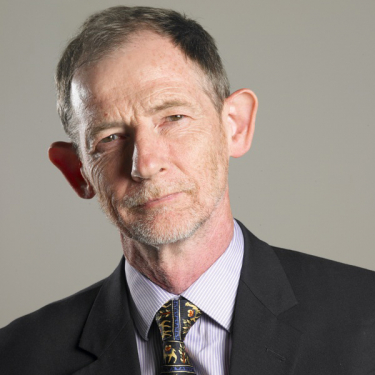I took my undergraduate degree in Mathematics at Cambridge before obtaining my DPhil in 1972 at the University of Sussex. Prior to starting at Queen’s in 1996 I was Professor of Applied Analysis at Heriot-Watt University in Edinburgh, where in 2018 I returned as Professor of Mathematics. I have held visiting professorships at the University of California at Berkeley, at the Université Pierre at Marie Curie, Paris, at the Tata Institute of Fundamental Research, Bangalore, at the Institute for Advanced Study, Princeton, and at the University of Montpellier II. I am a former President of the International Mathematical Union and member of the Executive Board of the International Council for Science.
Research
My main research areas lie in the calculus of variations, nonlinear partial differential equations, infinite-dimensional dynamical systems and their applications to nonlinear mechanics. In solid mechanics, I am especially interested in the mathematics of microstructure arising from phase transformations in solids, using models based on nonlinear elasticity, where the problem of predicting microstructure morphology is related to deep unsolved questions of the multi-dimensional calculus of variations such as understanding quasiconvexity. Another main interest is in the mathematics of liquid crystals, in particular concerning how defects can be studied using different models. Recently I have also become interested in problems of computer vision.
Publications
- J.M. Ball. Convexity conditions and existence theorems in nonlinear elasticity. Arch. Rat. Mech. Anal., 63:337–403, 1977.
- J.M. Ball. Discontinuous equilibrium solutions and cavitation in nonlinear elasticity. Phil. Trans. Royal Soc. London A, 306:557–611, 1982.
- J.M. Ball and V.J. Mizel. One-dimensional variational problems whose minimizers do not satisfy the Euler-Lagrange equations. Arch. Rat. Mech. Anal., 90:325–388, 1985.
- J.M. Ball, J. Carr, and O. Penrose. The Becker-Doring cluster equations: basic properties and asymptotic behaviour of solutions. Comm. Math. Phys., 104:657–692, 1986.
- J.M. Ball and R.D. James. Fine phase mixtures as minimizers of energy. Arch. Rat. Mech. Anal., 100:13–52, 1987.
- J.M. Ball and R.D. James. Proposed experimental tests of a theory of fine microstructure, and the two-well problem. Phil. Trans. Roy. Soc. London A, 338:389–450, 1992.
- J.M. Ball. Global attractors for damped semilinear wave equations. Discrete and Continuous Dynamical Systems, 10:31–52, 2004.
- J.M. Ball and A. Majumdar. Nematic Liquid Crystals: from Maier-Saupe to a Continuum Theory. Mol. Cryst. Liq. Cryst. 525 (2010) 1-11.
- J.M. Ball and A. Zarnescu. Orientability and energy minimization in liquid crystal models. Arch. Ration. Mech. Anal. 202 (2011), no 2, 493-535.
- J. M. Ball and R. D. James. Incompatible sets of gradients and metastability. Arch.Ration. Mech. Anal., 218(2015):1363–1416.
- J. M. Ball. Mathematics of liquid crystals. Molecular Crystals and Liquid Crystals, 647:1, 1-27.
- J. M. Ball. Axisymmetry of critical points for the Onsager functional. Phil. Trans. Roy. Soc, (2021, to appear).
